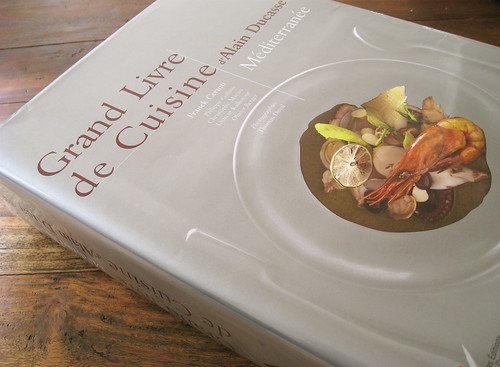
Before becoming a successful businessman and acclaimed globe-trotter restaurateur, Alain Ducasse was first and foremost a brilliant interpret of haute Mediterranean cuisine. Although not raised under the sun of the French Riviera (he's originally from Southwestern France), he apprenticed under legendary chef Roger Verge at Le Moulin de Mougins where he fell in love with the flavors of provencale cuisine. He would soon achieve the status of master of this genre himself by getting the much coveted Michelin awards first at La Terrasse of the Juana Hotel in Juan-Les-Pins (2 stars in 1984) and then at Le Louis XV, the restaurant of the Hotel de Paris in Monaco (3 stars in 1990). He would obviously not stop there and the rest is history.
However, fifty years from now, Ducasse may well be remembered not only for the quality of his cuisine or his financial success but rather for his ability to pass his knowledge on to the next generation of chefs and appoint the brightest at the helm of his flagship 3-star restaurants. Franck Cerutti belongs to this category of former pupils that have grown into master chefs. Born and bred in Nice, trained not only with Ducasse but also with Maximin and at Enoteca Pinchiorri in Florence before becoming chef de cuisine of Le Louis XV, he is a passionate, gifted and dedicated creator of haute Riviera cuisine that he has almost come to personify according to Ducasse.
Needless to say that a cookbook on Mediterranean cuisine directed by these two men is much more than a cookbook. "Mediterrannee" actually belongs to the "Grands Livres de Cuisine d'Alain Ducasse" series whose first three volumes were dealing with French haute cuisine, pastry and bistro / brasserie food, respectively. 1000 pages-plus thick, each of them looks more like an encyclopedia than your typical cookbook and contains elaborate recipes that require a good technical background, an extensive use of fond, jus, ... as well as time consuming prep work. They also give a unique insight into the work of other talented Ducasse's proteges such as Jean-Francois Piege, Didier Elena, Benoit Witz or Frederic Robert. In any event, they are an infinite source of knowledge for cooks of any level.
In keeping with its predecessors, "Mediterranee" is a tome. Ducasse's crew, helped by a team of historians, has gathered 500 recipes, some of them forgotten, spanning the whole western Mediterranean from France to Spain, Italy, Sicily, Malta, Morocco... And the book really succeeds in capturing the culinary unity of the region while also highlighting all the local specificities. Recipes are ranked by ingredient from A like Agneau to Y like Yaourt with a whole section dedicated to desserts and contributed by Olivier Berger, the pastry chef at Le Louis XV.
Each dish has been refined using classical technique and becomes a little jewel in the hand of Ducasse's band of artists as evidenced by this perfectly executed and beautifully plated ratatouille. Although demanding, recipes are well articulated and each process is carefully detailed (prep, cooking, finishing touches, plating, ...). Each recipe also comes with a header describing the history and origin of the dish as well as gorgeous pictures.
Above and beyond classics such as Salade Nicoise, Daube de boeuf, Caponata or Ajo Blanco, "Mediterranee" also includes recipes of dishes created by Cerutti and served at Le Louis XV. Cerutti revisits specialties like farcis a la nicoise or risotto a la truffe noire and turns them into masterpieces. Behind an apparent simplicity, each dish shows a flawless execution and the ever-present respect of the ingredients. This translates into "essential pleasures" as Cerutti likes to describe them.
The only weaknesses of "Mediterrannee"? Its price (120 EUR) and the absence of English translation for the time being. However, if you're lucky enough to afford it / receive it as a gift and speak a little French, I can promise it will become a favorite among your books. Like a bible, mine stays atop my bedside table and I keep coming back to it over and over again to find inspiration or simply peace of mind before sleeping.
 I'm leaving today for France and I suspect that tomatoes' season will be over when I'm back. That is the reason why I could not resist to buy these 5 beautiful "mini" heirloom tomatoes yesterday evening when I was shopping at Whole Foods. They are locally grown and bear the poetic names of Green Zebra, Cherokee Purple, Costoluto Genovese and Yellow Teardrop.
I'm leaving today for France and I suspect that tomatoes' season will be over when I'm back. That is the reason why I could not resist to buy these 5 beautiful "mini" heirloom tomatoes yesterday evening when I was shopping at Whole Foods. They are locally grown and bear the poetic names of Green Zebra, Cherokee Purple, Costoluto Genovese and Yellow Teardrop.





